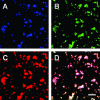Use of quantum dot luminescent probes to achieve single-cell resolution of human oral bacteria in biofilms
- PMID: 17114321
- PMCID: PMC1796960
- DOI: 10.1128/AEM.02164-06
Use of quantum dot luminescent probes to achieve single-cell resolution of human oral bacteria in biofilms
Abstract
Oral biofilms are multispecies communities, and in their nascent stages of development, numerous bacterial species engage in interspecies interactions. Better insight into the spatial relationship between different species and how species diversity increases over time can guide our understanding of the role of interspecies interactions in the development of the biofilms. Quantum dots (QD) are semiconductor nanocrystals and have emerged as a promising tool for labeling and detection of bacteria. We sought to apply QD-based primary immunofluorescence for labeling of bacterial cells with in vitro and in vivo biofilms and to compare this approach with the fluorophore-based primary immunofluorescence approach we have used previously. To investigate QD-based primary immunofluorescence as the means to detect distinct targets with single-cell resolution, we conjugated polyclonal and monoclonal antibodies to the QD surface. We also conducted simultaneous QD conjugate-based and fluorophore conjugate-based immunofluorescence and showed that these conjugates were complementary tools in immunofluorescence applications. Planktonic and biofilm cells were labeled effectively by considering two factors: the final nanomolar concentration of QD conjugate and the amount of antibody conjugated to the QD, which we define as the degree of labeling. These advances in the application of QD-based immunofluorescence for the study of biofilms in vitro and in vivo will help to define bacterial community architecture and to facilitate investigations of interactions between bacterial species in these communities.
Figures






References
Publication types
MeSH terms
Substances
Grants and funding
LinkOut - more resources
Full Text Sources
Other Literature Sources

